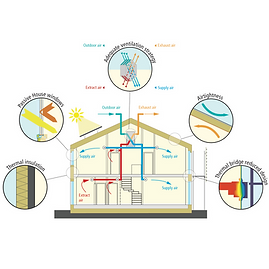Why Build Sustainably?
The main objectives of sustainable design are to reduce, or completely avoid, depletion of critical resources like energy, water, land, and raw materials. High performance buildings need significantly less energy and water to operate and choosing non-toxic, carbon storing building components reduce the GWP (Global Warming Potential) and provide a healthier living environment. Thoughtfully designed and constructed buildings are livable, comfortable, durable, safe, energy efficient, and beautiful. Passive House, LEED and Living Futures are different standards that prioritize sustainable construction. The B.E.A.M tool enables builders to calculate the GWP of the materials used during construction.

Passive House Fundamentals








This tool is a game-changer
bringing clarity to the carbon footprint of your building designs
BEAM stands for Building Emissions Accounting for Materials. It is a tool that allows architects and builders to analyze material carbon emissions. BEAM focuses on the structure, enclosure and partition assemblies as these sections of the building make up the majority of the material mass. Katja has completed the BEAM v1.1 Estimator Course and is able to provide clients with the knowledge necessary to make conscious material choices.

LEED CERTIFICATION
-
LEED (Leadership in Energy and Environmental Design) is the most widely used green building rating system in the world.
-
Available for virtually all building types, LEED provides a framework for healthy, highly efficient, and cost-saving green buildings.
-
LEED certification is a globally-recognized symbol of sustainability achievement and leadership.
Living Building Challenge
-
The Living Building Challenge (LBC) is a certification program that defines the most advanced measure of sustainability—providing a framework for design, construction and the symbiotic relationship between people and all aspects of the built environment.
-
It is one of most rigorous performance standards in the industry, as it requires net-zero energy, waste and water of every project.
-
Each facet of the Living Building Challenge is performance-based, so every building must measure for 12 consecutive months after completion before receiving certification.
-
When projects achieve this level of performance, they can claim to be the ‘greenest’ anywhere, and will serve as role models for future construction.

